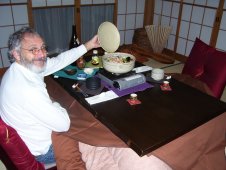On the taxi ride home from the train station I looked out the window, through the rain, at the familiar sights of Koriyama. The signs that seemed a mystery to me a little over a year ago were now mostly legible. The park where Chas and Tetsuya got drunk on Osake and sang Beatles songs (a sweet spring time memory) was wearing its winter garb, reminding me that the seasons had come full circle since our initial arrival. I saw the feisty, weathered oksan, proprietor of my favorite mom & pop vegetable market, sweeping off her stoop with a twig broom and bringing in her cabbages for the night. There was a very determined young man in an official looking uniform, authoritatively waving his baton, blowing his whistle, and bowing to the line of vehicles creeping slowly around a construction site. Teenagers on bicycles, balancing umbrellas in one hand while text messaging on cell phones with the other, and carrying on laughing conversations with their friends while dodging vehicles illegally parked on the sidewalks at the same time, didn’t phase me as the taxi driver weaved recklessly in and out of the line of traffic, driving in both lanes, sometimes in the face of on coming traffic, and ignoring most signals while carrying on a lively conversation with us and his dispatcher at the same time. A year ago the ride would have elevated my blood pressure. A year ago I would never have put together a sentence like that. Today both the bizarre traffic experience and the sentence construction is a part of being at home.
click photo for larger view







